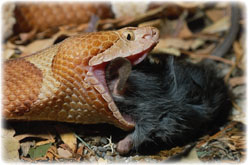Difference between revisions of "Snake Feeding and Digestion"
| Line 9: | Line 9: | ||
==Size and type of prey== | ==Size and type of prey== | ||
| − | The size of the prey can be about the same diameter as the snake's head. | + | The size of the prey can be about the same diameter as the snake's head. Snakes can be fed whole prey in order to mimic a snake's diet in the wild. The feeding of pieces of prey (for example feeding fish off-cuts to [[Garter Snake|garter snakes]]) can lead to diet related diseases). In general snakes will eat whole animals and nutritional problems are relatively uncommon. Aquatic species usually prefer fish and amphibian prey items while arboreal snakes usually prefer avian and reptilian prey items. Terrestrial snakes will readily accept different prey items. |
* Find out more information on [[Snake Diet|specific snake diets]]. | * Find out more information on [[Snake Diet|specific snake diets]]. | ||
Revision as of 15:00, 14 May 2010
| This article has been peer reviewed but is awaiting expert review. If you would like to help with this, please see more information about expert reviewing. |
All snakes are carnivores. With over 2900 different species, some snakes have highly specialised diets (eggs, lizards, frogs, fish, fish eggs or invertebrates such as slugs or termites) while others are generalists and will eat a wide variety of prey items. Common pet snakes such as rat snakes, milk snakes boas and pythons typically feed on rodents but some pet and many exhibition snakes require special diets. It is therefore necessary to have species-specific information to determine the most appropriate prey.
The gastrointestinal tract of the snake is simple and relatively short compared to other reptiles. Due to this aspect of comparative physiology, it is vital that these animals are given a high quality diet in captivity to maximise the absorption of essential nutrients.
- Find out information on the Snake Digestive System.
- Find out more about how the snake head is adapted to ingest whole prey in the Snake Musculoskeletal System.
Size and type of prey
The size of the prey can be about the same diameter as the snake's head. Snakes can be fed whole prey in order to mimic a snake's diet in the wild. The feeding of pieces of prey (for example feeding fish off-cuts to garter snakes) can lead to diet related diseases). In general snakes will eat whole animals and nutritional problems are relatively uncommon. Aquatic species usually prefer fish and amphibian prey items while arboreal snakes usually prefer avian and reptilian prey items. Terrestrial snakes will readily accept different prey items.
- Find out more information on specific snake diets.
Frequency of feeding
- Young, growing snakes may require food every 2 to 3 days.
- Active snakes such as garter snakes require several feeds per week.
- Small adult snakes may eat weekly or more often.
- Giant snakes may only eat 4 to 6 times yearly.
- Snakes may not feed during ecdydsis.
- Some snakes do not feed during the breeding season.
- Potential aetiologies for anorexia in snakes that can be hard to acclimate to captivity include inappropriate prey type or size (see diets), inappropriate environmental temperatures (see housing), dehydration, and chronic disease.
Royal Python
- Environmental cues can be important for feeding. A royal python is far more likely to eat a rodent that is similar in colour to agouti coloured free-living rodents. In captivity these snakes are often offered albino or fancy coloured mice rather than appropriately coloured prey and therefore do not receive the visual cues to eat.
Garter Snake
- The presence of thiaminases in frozen fish can lead to clinical disease in fish-eating snakes, such as garter snakes.
Preparation of food
Care of the prey item prior to feeding is important since nutritional deficiencies in the snake may occur if the animal being fed has been kept on an inappropriate diet. Similarly, if poor husbandry of prey items is practiced then they may serve as reservoirs for disease. Prey rodents should not have been treated with topical parasiticides e.g. permethrins, within three weeks of being offered to a snake (the dealer can confirm this). In addition, prey should not have been administered drugs such as antimicrobials and euthanasia compounds. In zoological institutions prey is often frozen at 0°C as a method of food preservation.
Snakes are heavily reliant on olfactory cues when hunting (see snake special senses, pet owners may be encouraged to "scent" a mouse or rat by rubbing an atypical prey species to stimulate feeding.
Feeding live prey
Food items should be humanely euthanised using carbon dioxide or cervical dislocation. Because snakes hunt using olfactory senses, they can be easily trained to accept euthanised prey. It is not recommended to feed live prey for several reasons:
- Excessive stress to the prey because of the environment.
- Injuries to the snake from the prey.
- Illegal in the U.K.
Obesity
In general, snakes are overfed in captivity and it is not uncommon to be presented with an obese animal in practice. To prevent obesity, snakes should be regularly weighed and measured, and a body condition score determined. See snake physical examination.
Water
Snakes derive a significant amount of water from their prey. Many species will also drink from standing water, therefore a large water basin that provides an additional soaking area is recommended. Soaking can help facilitate shedding and stimulate the gastrointestinal tract.
References
Fowler, M.E. and Miller, R.E. (2003). Zoo and Wild Animal Medicine. Saunders, 5th Edition. pp. 84. ISBN 0-7216-9499-3
Mitchell, M.A. (2004). Snake care and husbandry. Veterinary Clinics of North America: Exotic Animal Practice 7:2 pp. 421-446.
